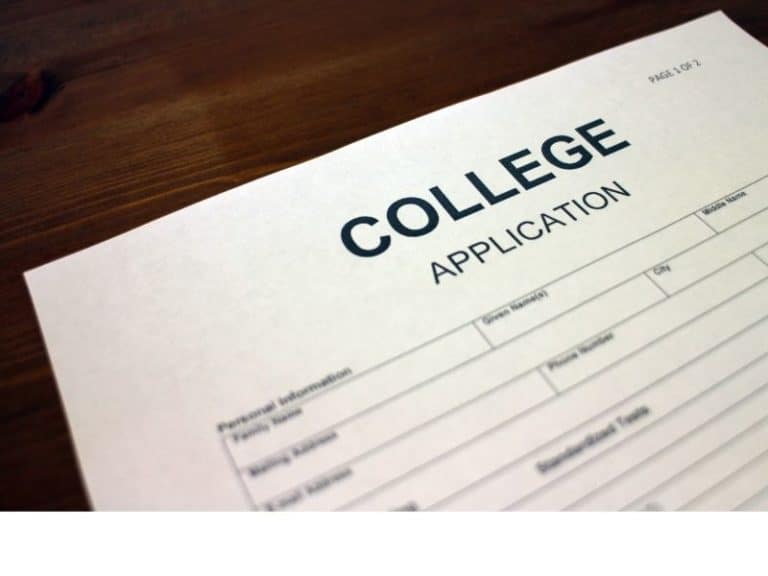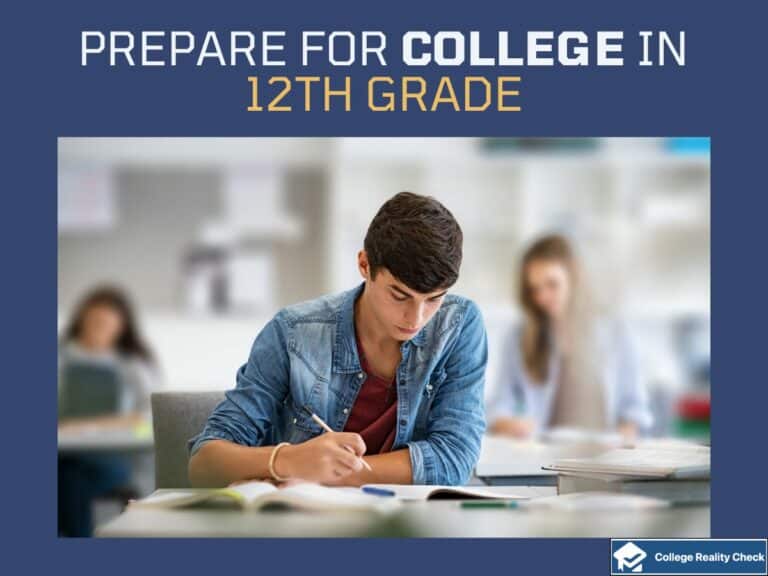How to Prepare for College in Middle School
It’s not too early to think about college in middle school.
While the main goal in middle school is to build a solid foundation necessary for a successful high school, planning for college early gives young teens enough time to explore their interests and passions.
It is important to plan academic and extracurricular choices when gearing up for college life and beyond.
While in middle school, students get ready for college by taking the steps listed below:
- Take Advanced and Honors Classes
- Maintain Good Grades
- Develop Strong Study Habits
- Get Involved in School and the Community
- Prepare for High School
- Talk to Parents About College
- Start Saving for College
- Read, Read, and Read More
- Learn a Foreign Language
- Ask for Help
1. Take Advanced and Honors Classes
Advanced or accelerated classes in middle school are high school-level classes. Although successful completion won’t cause middle schoolers to earn high school credits, taking the said classes, however, enables young teeners to experience what it’s like to be students in high school, thus allowing them increased academic success.
“Students who take advanced classes in middle school can plan to take on AP courses in high school, knowing they have the skills and knowledge required to succeed” (Marlborough, 2019).
In the college admissions process, high schoolers who take full advantage of honors classes available to them can help increase their chances of receiving an acceptance letter from their top-choice institutions.
While the same cannot be said for honors classes in middle school, early teens are still recommended to take them.
Honors classes cover pretty much the same things as general classes in middle school.
However, they are given at a faster pace and with additional demanding coursework, too.
As a result of this, young students develop new skills and are challenged to expand the way they think, which primes them for high school classes and lets them shine in those as well.
2. Maintain Good Grades
Middle school grades have no direct impact on college admissions.
Still, it can have a profound effect on the college careers and, ultimately, the professional careers, too, of middle schoolers as their experience in middle grade can influence the path they take in high school.
According to a team of researchers from EdSource, a non-profit journalism organization reporting on various education-related issues in California as well as the rest of the nation, success in key subjects in middle grade serves as a strong predictor of success in high school and beyond, too.
“In California, students’ scores on middle grades standards-based tests in math and ELA can signal their chances of passing the California high school exit exam, which they first take in 10th grade” (EdSource, 2010).
Having competitive subject grades and GPA in middle school is a sign of a student’s discipline, commitment, will, resilience and so much more, all of which can help him or her get and maintain high numbers in high school necessary for admission to the most competitive colleges in the land where strong academic performance is prized.
3. Develop Strong Study Habits
Study habits, simply put, is how a student studies.
According to a report by The Tenney School, a private school in western Houston, Texas, waiting until high school for a child to start developing solid study skills could prove to be too late. It adds that a young teen’s odds of reaping success in college can be significantly increased if they develop good study skills in middle school.
Students with good study habits are known to perform better on standardized tests such as the SAT and ACT as well as major exams in high school and, of course, college.
In the process, they also tend to develop other qualities necessary for academic success, including the following:
- Competence
- Concentration
- Confidence
- Memorization
- Note-taking
- Organization
- Reading comprehension
- Self-esteem
- Time management
With the high school GPA serving as the single most important factor in the college admissions process, entering secondary school armed with well-established study skills allows a student to focus on getting good grades from the get-go.
4. Get Involved in School and the Community
In most instances, extracurriculars account for about 30% of a college-bound teen’s application.
Participation in many different on-campus activities allows a middle schooler to explore his or her interests, thus increasing the chances of spending most time outside of the classroom in high school in meaningful EAs, which are exactly what college admissions officers would like to see on the activities section of the Common App or Coalition App.
Additionally, involvement in them allows a student to learn new things and discover several career options.
Even though it’s true that middle school students can explore various on-campus extracurriculars, community involvement adds another dimension to their experience, which can make their college applications pop.
As a matter of fact, according to a report by Niche, community service is deemed important by many college admissions officers, around 53% of whom agree that it can serve as a tie-breaker between equally qualified students, because it indicates that the individual is likely to contribute to the university’s mission and be active on campus outside of the classroom.
5. Prepare for High School
It’s true that secondary school is a smaller world than postsecondary school.
Still, middle school students should attend a high school that meets their academic, extracurricular and personal needs, which is pretty much the same thing that high schoolers should ensure when choosing a college to apply to.
Before young teens graduate from middle school, they should seek the assistance of their parents or guardians in looking for high schools or special programs that will benefit their interests the most. Similarly, they may set a schedule with their counselors, teachers or mentors to discuss the very important matter in their educational careers.
Of course, taking a high school campus tour helps middle schoolers learn more than what brochures say as well as have a better sense of the lives of high schoolers inside the campus and also a feel of the high school campus itself.
6. Talk to Adults About College
A good indication of early college readiness is when your child starts asking questions about future careers.
I found that visiting college campuses sparked my children’s interest in postsecondary education.
“Early exposure to a college campus makes a difference, especially for rural students who have little opportunity to visit colleges. Federal grant dollars are now being tied to increasing college awareness at an early age. As a result, there are more schools and groups seeking campus visits for younger students“ (Oregon Gear Up, 2014).
Meanwhile, according to researchers at the University of Arkansas (U of A) and Saint Louis University, as reported by EAB, college campus visits among middle school students bring the various advantages listed below:
- Improved chances of speaking with school staff about college
- Advanced knowledge of college-related matters
- Increased rate of taking advanced and honors classes
7. Start Saving for College
According to the Education Data Initiative, the average cost of attendance at a public in-state college is $25,707 per year or $102,828 over 4 years or $54,501 per year or $218,004 over 4 years at a private, non-profit college.
College may be years away from middle school, and it’s a great time to start saving for it — if parents haven’t yet.
For many families, it can take many years to plan for the college careers of their kids.
There are simply a lot of aspects to consider about the dream of their little ones to become bachelor’s degree holders, including the type of college of choice and the major. Because of this, it can be challenging to determine what might be relevant to consider and what might be not.
When it comes to saving for college, the sooner parents start, generally speaking, the better. As a matter of fact, some experts suggest getting started even before their children are born.
Some of the most popular savings options for college goals are as follows:
- 529 plans — also known as college saving accounts
- Education savings accounts (ESAs)
- Savings bonds
- Savings accounts
- Employer-sponsored education plans
- Trust funds and other inheritance — or gift options
- Certificates of deposit
8. Read, Read, and Read More
Reading a lot during middle school helps students attain stronger verbal, writing and critical thinking skills, which they will need for high school reading assignments and, more importantly, in preparation for and taking the SAT and ACT. Although it’s true that scores are not required by 80% of colleges, they are still required for some competitive programs and financial aid.
Not only will grabbing reading materials improve vocabulary and reading comprehension skills, both of which allow SAT and ACT test-takers to understand questions and give answers on time, but also introduce new ideas and perspectives.
However, it’s not enough for a middle schooler to opt for just about any reading material.
“The more you read challenging materials, the faster you’ll read, and the better you will comprehend. These skills will help you on the SAT Critical Reading and ACT Reading tests.” (Lubell, 2012).
9. Learn a Foreign Language
It’s not uncommon for some of the most selective colleges and universities in the US to require applicants to have 2 to 3 years of foreign language.
However, some of the top applicants will have 4 years of them.
While gaining mastery of a foreign language in middle school won’t count in the college admissions process, it can serve as a major contributor to high school foreign language classes, which will matter importantly when it’s time to send applications to top postsecondary institutions where those with the least rigorous secondary school record are typically denied entry.
Besides, according to professors in Tokyo, Japan, the more languages an individual speaks, the easier it will be for him or her to learn another.
Meanwhile, the Center for Applied Linguistics says that learning foreign languages, especially at an early age, impacts overall intellectual growth as well as mental development.
10. Ask for Help
Middle schoolers should not feel too embarrassed to ask for help from adults.
For instance, they may approach their relatives and family friends who they believe have interesting jobs and ask them about important things such as what aspects of their work they like and what sort of education they sought.
Numerous individuals on the middle school campus may also provide helpful information about matters related to college degrees and professional careers, including counselors, teachers, coaches and librarians — eventually, having an idea of the academic curiosity and dreams of students will make these people excellent middle school recommendation letter writers.
However, it’s not just for college- and career-related purposes that young students should ask for help but also in terms of keeping their grades up, especially if they are having trouble with their coursework.
Read Next: How to Prepare for College in High School
How to Start Preparing for College in Middle School
To start preparing for college in middle school, young teens should establish good study skills, take advanced or honors classes, and participate in meaningful extracurricular activities that will increase their chances of succeeding in high school, which is vital for college admissions.
As early as in middle grade, though, they may start researching colleges as well as take college tours.
According to an Inside Higher Ed report, the quality of high school is a key predictor of college grades not only in freshman year but also the subsequent years, from sophomore to junior years.
So, to prepare for college, middle schoolers should also consider preparing for high school, which comes first.
Do Colleges Look at Middle School Grades?
College admissions officers do not take into account middle school grades when deciding which applicants to accept.
For the most part, they can make informed decisions based solely on high school grades, which are impacted by the academic foundations set in middle school, as well as other application components, particularly where a holistic admissions policy is employed.
Even though the experiences and achievements in middle school are not important in the college application process, they nonetheless can have a profound effect on one’s high school performance, which matters in college admissions.
What Grade Should You Start Visiting Colleges?
The best time for students to take tours of the campuses of postsecondary institutions they wish to shortlist — and thus have researched — is in the spring of the junior year of high school.
However, students in 8th grade may also start taking campus tours to develop a college-going identity, which gives them a sense that they would be welcome additions to the campus.
Northern Arizona University has a toolkit for 8th graders that aims to provide middle school kids grade-appropriate info to help them gain access to as well as attain success in higher education and also to help solidify their college plans.
Can Middle Schoolers Take College Classes?
Some colleges, particularly community colleges, allow middle school students, especially 7th and 8th graders, to take introductory college courses, typically after their respective intermediate classes.
In some instances, they may also earn credits that are transferable to many community colleges as well as 4-year degree-granting institutions.
According to a 2016 EdSource report, Chabot College, a public community college in Hayward, California, teaches college classes at 5 middle schools — it’s in a district that may be the only one in California and perhaps in the US to offer such.
Should Middle School Students Have Jobs?
Teens who work less than 15 hours per week tend to get better grades than those who don’t because they obtain various skills, including time-management and communication skills, as well as develop a greater sense of self.
However, in the US, the minimum age for employment is 14 years old and the type of work and number of hours of work are limited, too.
The Fair Labor Standards Act (FLSA) by the US Department of Labor states that the minimum age for employment is 14. It also limits the type of work people under 16 can take on as well as how long they can work per week.
College Prep Programs for Middle School Students
Several initiatives aim to prepare middle school students for high school to, in most instances, raise the percentage of those who advance to secondary school as well as to increase retention rates and graduation rates.
Some of the said programs, which are administered by adult advisers, are designed to help middle schoolers win acceptance to college-preparatory high schools.
Most college prep programs for middle school teens are federal initiatives, such as the Texas Gaining Early Awareness and Readiness for Undergraduate Programs (Texas GEAR UP) and also the California State University system’s How to Get to College for 6th, 7th and 8th grade students.
How to Prepare for College in High School
Preparing for college, especially competitive ones, in high school usually involves taking challenging college-level courses, such as AP and IB classes, and acing the SAT or ACT as well as spending time to meet some of the non-academic requirements of top-choice postsecondary institutions, including extracurriculars, volunteer work and work experience.
In gearing up for their college careers, high schoolers must carefully research the institutions they wish to attend to have a much better idea of what sort of students they admit, thus allowing them to do everything necessary to get into them.
References
- Marlborough (2019, November 4). Five Benefits of Taking Advanced Classes in Middle School. Marlborough.org. https://www.marlborough.org/news/~board/stem/post/benefits-of-taking-advanced-classes-in-middle-school
- Oregon Gear Up (2014). Campus Visits for Younger Students: Strategies and Resources for Colleges to Engage Younger Students. Oregon Gear Up Toolkit, 4.
- Lubell, L. (2012). Six Ways to Improve SAT and ACT Scores: Reading, English and Writing. InLikeMe.com, 1.
- EdSource (2010). Gaining Ground in the Middle Grades: Why Some Schools Do Better – A Large-Scale Study of Middle Grades Practices and Student Outcomes. Narrative Summary of Findings: February 2010, 2.
Disclaimer: The views and opinions expressed in this article are those of the authors and do not necessarily represent those of the College Reality Check.






